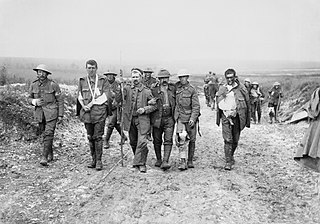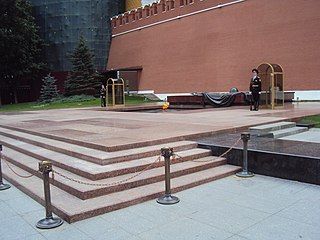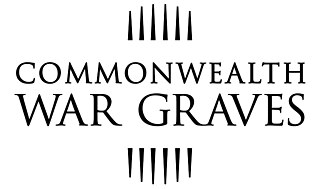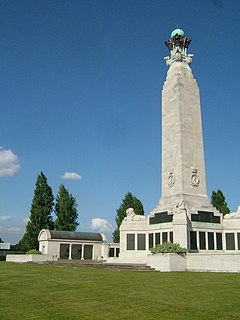
The total number of military and civilian casualties in World War I was about 40 million: estimates range from around 15 to 22 million deaths and about 23 million wounded military personnel, ranking it among the deadliest conflicts in human history.

A Tomb of the Unknown Soldier is a monument dedicated to the services of an unknown soldier and to the common memories of all soldiers killed in war. Such tombs can be found in many nations and are usually high-profile national monuments. Throughout history, many soldiers have died in war with their remains being unidentified. Following World War I, a movement arose to commemorate these soldiers with a single tomb, containing the body of one such unidentified soldier.

Imperial War Museums (IWM) is a British national museum organisation with branches at five locations in England, three of which are in London. Founded as the Imperial War Museum in 1917, the museum was intended to record the civil and military war effort and sacrifice of Britain and its Empire during the First World War. The museum's remit has since expanded to include all conflicts in which British or Commonwealth forces have been involved since 1914. As of 2012, the museum aims "to provide for, and to encourage, the study and understanding of the history of modern war and 'wartime experience'."

The Commonwealth War Graves Commission (CWGC) is an intergovernmental organisation of six independent member states whose principal function is to mark, record and maintain the graves and places of commemoration of Commonwealth of Nations military service members who died in the two World Wars. The commission is also responsible for commemorating Commonwealth civilians who died as a result of enemy action during the Second World War. The commission was founded by Sir Fabian Ware and constituted through Royal Charter in 1917 as the Imperial War Graves Commission. The change to the present name took place in 1960.

The Tower Hill Memorial is a pair of Commonwealth War Graves Commission memorials in Trinity Square, on Tower Hill in London, England. The memorials, one for the First World War and one for the Second, commemorate civilian merchant sailors and fishermen who were killed as a result of enemy action and have no known grave. The first, the Mercantile Marine War Memorial, was designed by Sir Edwin Lutyens and unveiled in 1928; the second, the Merchant Seamen's Memorial, was designed by Sir Edward Maufe and unveiled in 1955. A third memorial, commemorating merchant sailors who were killed in the 1982 Falklands War, was added to the site in 2005.

A war memorial is a building, monument, statue, or other edifice to celebrate a war or victory, or to commemorate those who died or were injured in a war.
Sir Thomas Brown (1705–1746) was born in Kirkleatham, in present-day Redcar and Cleveland, in the north-east region of England. He was a hero of the Battle of Dettingen, in Bavaria during the War of the Austrian Succession; the last time that a British monarch, in this case King George II, personally led his own country's troops into battle.

Chatham Naval Memorial is a large obelisk situated in the town of Chatham, Kent, which is in the Medway Towns. The memorial is a feature of the Great Lines Heritage Park. The huge expanse of the Great Lines was in its own right a layer of defence to protect Chatham Dockyard from attack.

Streatham Park Cemetery is a cemetery and crematorium on Rowan Road in Streatham Vale. It has always been privately owned and managed and is now part of the Dignity_plc group. The South London Crematorium is situated within the cemetery grounds and opened in 1936.
The War Graves Photographic Project original aim was to photograph every war grave, individual memorial, Ministry of Defence grave, and family memorial of serving military personnel from WWI to the present day. However, due to its popularity the project has now extended the remit to cover all nationalities and military conflicts and make these available within a searchable database. These memorials are all over the world where British, Commonwealth and other nations servicemen and women are buried or commemorated.

Scottish war memorials are found in all communities in Scotland. They are found on most main streets and most churches in Scotland. Many commemorate the sacrifice of the First World War but there are many others to wars before and since 1914–1918.
The Honorable Henry Arnold Lawrence was a rugby union forward who played club rugby for Richmond F.C. and international rugby for England. He was the third captain of the England rugby team.

Findmypast is a UK-based online genealogy service owned, since 2007, by British company DC Thomson. The website hosts billions of searchable records of census, directory and historical record information. It originated in 1965 when a group of genealogists formed a group named "Title Research". The first internet website went live in 2003.

American War Memorials Overseas (AWMO) was founded in 2008 and is a non-profit corporation working to document, promote, and preserve non-government supported War Memorials honoring Americans outside of the United States. American War Memorials Overseas is a 501(c)(3) nonprofit corporation and as such is entirely dependent on donated funds.
War Memorials Trust works for the protection and conservation of war memorials in the UK. The charity provides free information and advice as well as administering grant schemes for the repair and conservation of war memorials.

The First World War centenary is the centenary of the First World War, which began on 28 July 2014 with a series of commemorations of the outbreak of the war organized across the continent of Europe, and ended on 11 November 2018 with multiple Armistice centenary commemorations held globally, including an international ceremony in Paris.

War memorials were erected in many towns of Queensland, Australia, in commemoration of the service and death of many Queenslanders in World War I.

Casualty recording is the systematic and continuous process of documenting individual direct deaths from armed conflict or violence. It aims to create a comprehensive account of all deaths within a determined scope, usually bound by time and location. At minimum, casualty recording typically involves documenting the date and location of a violent incident; the number of people killed; the means of violence or category of weapon used; and the party responsible. Casualty recording differs from casualty tracking by military actors to track the effects of their operations on the civilian population for the purpose of improving their procedures and reducing civilian casualties.

Kingston upon Thames War Memorial, in the Memorial Garden on Union Street, Kingston upon Thames, London, commemorates the men of the town who died in the First World War. After 1945, the memorial was updated to recognise casualties from the Second World War. The memorial was commissioned by the town council and was designed by the British sculptor Richard Reginald Goulden. The memorial includes a bronze statue of a nude warrior, carrying a flaming cross and wielding a sword with which he defends two children from a serpent, erected on a granite plinth, with bronze plaques listing the names of the dead. Goulden designed a number of such allegorical memorials, including others at Crompton, Greater Manchester, and Redhill, Surrey. The Kingston memorial was designated a Grade II listed structure in 1983. This was revised upwards in 2016 to Grade II*, denoting a building or structure of particular importance.
















